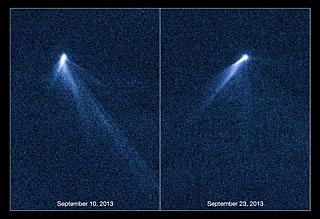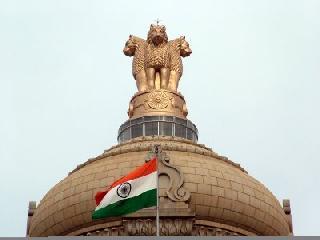
The asteroid, designated P/2013 P5, has six comet-like tails. A Hubble photo
WASHINGTON (PTI): Astronomers have for the first time seen an asteroid with six comet-like tails of dust radiating from it like spokes on a wheel.
The findings were made by astronomers viewing our Solar System's asteroid belt with NASA's Hubble Space Telescope.
Unlike all other known asteroids, which appear simply as tiny points of light, the asteroid, designated P/2013 P5, resembles a rotating lawn sprinkler and has puzzled astronomers with its unusual appearance.
"We were literally dumbfounded when we saw it," said lead investigator David Jewitt of the University of California at Los Angeles.
"Even more amazing, its tail structures change dramatically in just 13 days as it belches out dust. That also caught us by surprise. It's hard to believe we're looking at an asteroid," said Jewitt, leader of the team whose research paper appears in the Astrophysical Journal Letters.
P/2013 P5 has been ejecting dust periodically for at least five months. Astronomers believe it is possible the asteroid's rotation rate increased to the point where its surface started flying apart.
They do not believe the tails are the result of an impact with another asteroid because they have not seen a large quantity of dust blasted into space all at once.
Scientists using the Pan-STARRS survey telescope in Hawaii announced their discovery of the asteroid on August 27.
P/2013 P5 appeared as an unusually fuzzy-looking object.
The multiple tails were discovered when Hubble was used to take a more detailed image on September 10.
When Hubble looked at the asteroid again September 23, its appearance had totally changed. It looked as if the entire structure had swung around.
Careful modelling by team member Jessica Agarwal of the Max Planck Institute for Solar System Research in Lindau, Germany, showed that the tails could have been formed by a series of impulsive dust-ejection events.
She calculated that dust-ejection events occurred April 15, July 18, July 24, August 8, August 26 and September 4.
Radiation pressure from the Sun stretched the dust into streamers.
Radiation pressure could have spun P/2013 P5 up. Jewitt said the spin rate could have increased enough that the asteroid's weak gravity no longer could hold it together.
If that happened, dust could slide toward the asteroid's equator, shatter and fall off, and drift into space to make a tail.
Jewitt said it appears P/2013 P5 is a fragment of a larger asteroid that broke apart in a collision roughly 200 million years ago.
 Previous Article
Previous Article Next Article
Next Article













The Indian Air Force, in its flight trials evaluation report submitted before the Defence Ministry l..
view articleAn insight into the Medium Multi-Role Combat Aircraft competition...
view articleSky enthusiasts can now spot the International Space Station (ISS) commanded by Indian-American astr..
view article